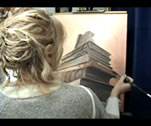This section provides a list of techniques, materials, and common references that are frequently used in the design and decorative painting profession.
they encompass malachite faux finish, wood graining, marbling, bronzing, faux stone, basket weaving, tortoise shell, and many more anonymous glazes that do not bare a resemblance to natural materials or patterns. When opting for a faux finish, you should always consider the possibility of growing tired of the artwork after a while. Unless you own a restaurant or a commercial space, it is safer to stay with a muted and more discreet glaze that will accommodate the widest range of decorative elements.
It means false, unreal, and describes the artistic work that simulates a real material with the help of paint or glaze. Almost any natural or man-made material can be imitated. It is not always the exact rendition that is sought by the artist, or that measures its success. In some instances it can be sketchy yet sufficient to bring the flair of the replicated material. But the true material needs imperatively to be studied and from there, the artist will derive his/her interpretation. On Early American specimens of furniture, colonial chests or armoires for instance, you see samples of rustic graining that have a naivety and beauty of their own. The creativity and intention of the artist is visible in the imitation; what drives him is the artistic impact and serendipity, in situ or not.
Many decorators favor a flat sheen; it offers a soft aspect, yet has a tendency to look quickly dull and dirty. It is also hard if not impossible to clean although new mat finishes have improved on this register; their sheen however leans towards a satin finish. Ceilings are ideal surfaces for a flat paint: it hides imperfections better than any glossy paint. For murals, flat paint is also a favorite; the eye is not distracted by any glare on the surface of the wall that compromises the painted decor.
painted floors can improve a room tremendously. From a design covering the entire surface to a simple border, one can tie up an elegant decor with a simple jar of paint and a sense of perspective. It is also a solution to hide damaged or cheap floorboards or other materials. Before embarking on this project however, keep in mind that removing a dark stain or paint covering the whole floor, will imply seriously sanding down the floorboards, which will compromise their already meager thickness; this is especially true of modern ones. When you sell your house or become tired of your choice, you may be confronted to this drawback. Always question the invasiveness of staining or of a painted design. Hard wood floors need to be protected by varnish or paint. Acrylic as well as oil-based varnish will suit this purpose. The advantage of the acrylic varnish over the oil one is its non-yellowing property. This default is occulted with a dark colored wood, however a light painted floor, the yellowing, that may turn even to orange, can be unsightly. A pattern can be applied over an already varnished floor, on the condition that you sand the varnish enough to give some tooth to receive the paint. Acrylic or latex paint is ideal for this type of work, for its quick drying time that allows the application of several coats on the same day. To protect the painted pattern, you may want to apply up to six or seven coats of acrylic varnish, and wait one week for the layers to be cured until you can walk freely on it. Remember that large patterns enlarge volumes, and that furniture must be accounted in the scheming of the floor design, not only for their position in the room but in consideration for their style. Floors that are "bleached" with a solution that leaves an ivory film on the wood are quite delicate and will easily show dark streaks, from chairs, rubber soles or wheels. Ebonized floors will show every spec of dust and require daily cleaning to fight this inconvenience.
it is a repeated pattern that typically appears on the top of walls to accentuate the ceiling line, to follow chair rails, to mark the perimeter of floors, and so forth. This is an easy way to personalize a room and give it, according to the theme of the frieze, a classical, rustic or modern feel. It is less invasive than a mural, and very effective in a room encumbered by furniture and paintings. You can choose between floral patterns, geometric ones, letters, mottos, and period designs such as Art Deco art or one of ethnic reference.






